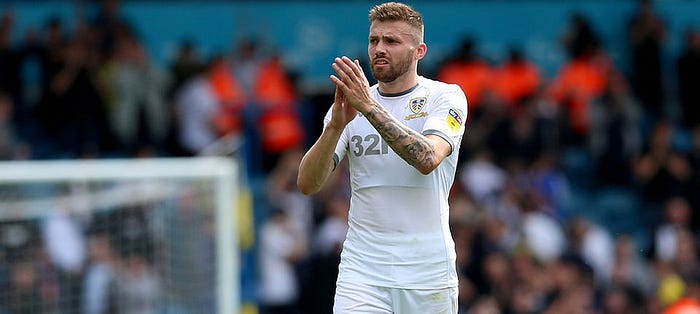Stuart Dallas: Leeds’ Unlikely Hero

In this piece, Josh Hobbs takes a look at Stuart Dallas’ performances so far this season to see why Leeds’ unlikely hero has been impressing…
Until the disastrous climax of the 2018/19 season, many Leeds fans probably wouldn’t have responded with much more than a shrug of the shoulders if Stuart Dallas had been one of the players to leave in the great exodus of unwanted squad players that took place this summer.
Fast-forward to the end of September 2019 and he is being hailed as one of the best players in Marcelo Bielsa’s side — certainly the most consistent — and has been rewarded with a new 4-year deal, a huge show of faith in the 28-year-old.
Quite the turn-around for the Northern Irishman who was initially signed as a left winger from Brentford. He never truly impressed there or on the right flank, only managing to contribute 5 goals in his highest-scoring season (15–16).
Under Bielsa, a manager known for appreciating players who can be utilised in multiple positions in the tactical system, Dallas has featured on both wings and in both full-back positions. He was even brought on as an auxiliary central midfielder on 2 occasions in 18/19.
After finishing last season in spectacular fashion at left-back — scoring twice in a heroic individual performance as the rest of the side crumbled around him in the playoff second-leg defeat — Dallas found himself with an opportunity to make a long-term spot in the starting lineup his own.
An injury to Luke Ayling in pre-season meant that the first choice right-back is only just returning to full fitness at the end of September. Since then, Dallas’ performances have been exemplary and Ayling will surely now have a fight on his hands to get back into the starting lineup.
So what has made the Cookstown Cafu stand out so far this season?
Partnership with Pablo Hernandez
As anyone who has read the content on this channel will know by now, Leeds favour the right-hand side during the build-up phase. In doing so, they look to overload opposition full-backs with Pablo Hernandez drifting inside, Mateusz Klich coming out to support and Dallas making the overlapping run from the full-back position.
A key part of Dallas’ contribution to the team, then, comes through his partnership with the man in front of him: Leeds chief playmaker, Hernandez.
That partnership has played out as Leeds’ highest passing combination so far. They have passed to each other a total of 219 times, averaging 27 per game with a season-high 41 passes between them coming in the 1–1 draw against Nottingham Forest.
The graphic below details Leeds’ passes from that game, using the players average positions (calculated through touches of the ball). The thicker the line, the more often the same pass was made.
As you can see, the combination of Dallas & Hernandez is by far the most potent combination.
Whilst many full-backs in the league may play a lot of sideways passes to centre backs and central midfielders and then make runs down the line to put crosses in, Dallas has a role to play for Leeds in a playmaking sense as nobody in the side gives the ball to Hernandez as much as the former Brentford man.
This is illustrated by this graph, which shows that Dallas plays the second most passes p90 and most progressive passes p90 of any full-back in the league.
Forward Runs
As the player report above shows, Dallas ranks above the 80th percentile of Championship right-backs for progressive runs, showing his confidence in carrying the ball forwards. (Progressive runs are runs of 30m or more that start in a player’s own half and end in the opposition half, or a run of 10m or more entirely in the opponents half.)
Dallas is most impressive in the shots p90 and touches in opposition box p90 metrics, ranking in the 100th percentile for both of those.
This is a hallmark of a Bielsa full-back. He loves them to get inside the opposition box, ideally scoring at the back post from a cross from their opposite full-back. Dallas scored this way in the final league game of 2018/19, getting on the end of a Luke Ayling cross.
Whilst Dallas’ touches in the box have not resulted in any assists so far (of which more later), he has a goal already and it was his shot, saved by Kelle Roos, that rebounded in for an own goal to give Leeds the lead against Derby.
His goal against Stoke though was perhaps Leeds’ goal of the season so far. A lot of words have been written about the pass Hernandez made for the assist, but it’s the run from Dallas, this time deployed in a right wing-back role in a 3–5–2 formation that we’ll look deeper at here:
At the beginning of the play, Dallas — highlighted at the top of the screen — is in a relatively harmless position as far as Stoke are concerned: just outside the centre circle as Adam Forshaw recovered the ball.
Beginning to stride forwards as Forshaw moved inside, the right wing-back made the vital run as soon as Forshaw played the ball into the feet of Jack Harrison. Liam Lindsay, the left-sided centre-back for Stoke, seemed to have no idea at all about the danger.
With Harrison playing the ball to Hernandez with one touch, suddenly Stoke were wide open and the Championship’s most dangerous playmaker seemed to know instantly where Stuart Dallas was running to, weighting the ball perfectly as he passed it to the edge of the penalty area.
Far too late, Lindsay finally realised the danger his side were in but could do nothing as Dallas streaked past him and finished first-time, passing the ball into the bottom corner.
Marcelo Bielsa is known for utilising ‘3rd man runs’, where a player not involved in the build-up makes a run forward to receive a pass in a dangerous position.
This goal could very well have come straight from the training ground. In the moment, it seemed to be wonderful vision from Hernandez, but no doubt those hours of practice created this goal.
Crossing
One ugly part of Dallas’s player report graphic is the crossing accuracy.
As with all the players operating in wide positions for Leeds, Dallas has an extremely high amount of crosses p90 but a very poor accuracy: in this case 23.08%.
On this occasion — coming in Leeds 2–0 win away at Barnsley — Dallas made a brilliant overlapping run to receive the ball in space from Pablo Hernandez. Frustratingly, though, his cross went straight to the first defender to clear.
In the next example — against Forest in the 1–1 draw at Elland Road — Dallas raced on to a fantastic ball by Kalvin Phillips into the opposition left-back channel. Unfortunately, his cross cleared the box completely.
This is certainly not the easiest crossing opportunity, as the ball was bouncing and he was running at top speed. However, these are the types of positions that Patrick Bamford, running to the near post, would have been hoping for better from his teammate.
Looking at a more positive example: in the Derby draw, Dallas once again made a brilliant overlapping run as Hernandez had drifted inside. Receiving the ball wider than he’d asked for from Bamford, Dallas managed to dig out an excellent cross to the back post and would have hoped for better from Jack Harrison and Gjanni Alioski, who seemed to get in the way of one another in seeking to turn it home.
Crossing is an issue for every wide player at Leeds, but Dallas will certainly want to improve on his stats in this area and would be looking to add assists to what is an excellent all-round game.
Conclusion
Luke Ayling has been a favourite of Bielsa’s since the Argentinian joined the club and has always come into the starting lineup when he has been fit.
Whilst the former Bristol City man may be considered the de facto right back at Leeds United, with Dallas performing like this, winning his place back will surely be a greater challenge than he has ever had before.
You can follow Josh Hobbs on Twitter @JoshAHobbs.
If you have any interest in contributing to this blog, get in touch with us @AllStatsArentWe
